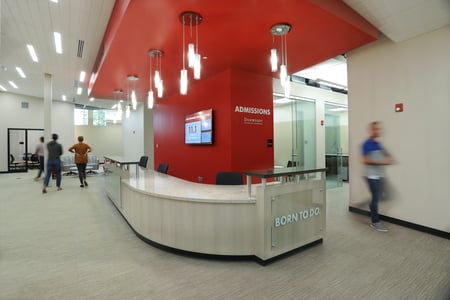
September 26 2019
The admissions entrance in the renovated gymnasium at Dunwoody College of Technology, Minneapolis, MN.
The enrollment funnel as a pure indicator of institutional growth is a misnomer. Many institutions have so aggressively built the top of their funnel, it is no longer an accurate predictor of new student yield. In our last enrollment blog, we talked about four roadblocks to building the top of your funnel and how to overcome them.
Blog by Tim Fuller, Credo Senior Affiliate
Today, we will continue the enrollment funnel mini-series with 5 tips on how to build your funnel so you can trust the data you have and enroll more best-fit students:
- Invest carefully in the top of the funnel, especially when you work with an outside vendor. Respect their expertise but exercise good judgement and ask probing questions to make sure your strategy aligns with mission, fit and resources. Remember they have a built-in motivation to drive (and sell) volume, so the discipline to be appropriately targeted in name purchases and search parameters is ultimately your responsibility.
- Disaggregate your funnel data regularly to evaluate initial sources of contacts and other key metrics such as academic programs and geography. Which sources are working well? Consider investing more in them. Which ones are not working? Shift these resources to more productive initiatives and investments.
- Track referrals and legacies intentionally. Be sure to thoroughly and systematically mine sources closer to you like referrals from alumni, current students, parents of current students, and your own faculty/staff. This often happens organically; take steps to make it an intentional and regular part of your practice.
- Measure the funnel impact of your team travel and other initiatives. Focus on movement down the funnel as the key metric, not initial inquiry or application interest. Pay attention to second and third contacts on the road and elsewhere which pushed students to visit and/or apply to measure full effectiveness of your strategies.
- Study your data and adapt to ensure you are getting the most out of your current funnel. How do your yield rates along the funnel compare to your peer and aspirant institutions? One of the opportunities we often see when studying funnel data is completion rates. In our enrollment research with a national organization, the average completion rate (applicants who turn in everything so you can make an admission decision are considered complete) hovers around 70%. If you get 1,000 applications at this completion rate, focusing attention on improving it to 80% brings you 100 more completed applications and a requisite increase in admits as well.
Increasing funnel yield is more than pushing a button or paying an outside vendor; it takes thought, planning, and intentional follow-up. If you can be intentional at the top, it will help with prediction as you go down. Building the top of the funnel—and the entire funnel—is integral to strategic enrollment growth, but you have to go about it the right way!
Related Blog Posts
Recent Posts
- Richard Dunsworth, J.D., To Receive 12th Annual Courageous Leadership Award December 16 2024
- Meet the 2024 Credo Values Award Recipients August 27 2024
- What is Executive Coaching, Really? June 25 2024
- Credo & The Constructive Dialogue Institute Announce A New Partnership For Higher Education Leadership Development March 7 2024
- Celebrating Women And Gender-Diverse Learners & Leaders February 28 2024
Categories
- Strategy
- Leadership
- Student Success
- Student Success & Retention
- Enrollment
- Pivot
- Strategic Planning
- Leadership Development
- News
- Strategic Enrollment
- Campus Planning and Architecture
- Moving the Needle
- Data
- Research
- Retention
- Campus Master Planning
- Enrollment & Financial Aid
- Academic Programming
- Campus Planning
- Thriving
- Admitted Student Research
- Architecture
- Finance
- Advising
- Admissions



